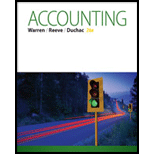
Concept explainers
1.
It is that form of organization which is owned and managed by two or more persons who invest and share the
To prepare: An income statement for 2016, indicating the division of the income.
1.
Explanation of Solution
The income statement for 2016 of L&Y is as follows:
| L &Y | ||
| Income Statement | ||
| For the Year Ended December 31, 2016 | ||
| Professional fees | $395,300 | |
| Operating expenses: | ||
| Salary expense | $154,500 | |
| |
$15,700 | |
| Property tax expense | $12,000 | |
| Heating and lighting expense | $8,500 | |
| Supplies expense | $6,000 | |
| Depreciation expense—office equipment | $5,000 | |
| Miscellaneous expense | $3,600 | |
| Total operating expenses | $205,300 | |
| Net income | $190,000 | |
Table (1)
Hence, the net income of L&Y for the year 2016 is $190,000.
Division of net income:
The following table shows the division of net income between the partners.
| L | Y | Total | |
| Salary allowance | $45,000 | $54,700 | $99,700 |
| Interest allowance | $13,500 (1) | $7,800 (2) |
$21,300 |
| Remaining income (1:1) | $34,500 | $34,500 | $69,000 |
| Net income | $93,000 | $97,000 | $190,000 |
Table (2)
Working note for the calculation of Interest allowance of L & Y
Interest Allowance is at 10%:
Note: Y invested additional $10000 on April 10, 2016 so, it should not be considered for calculating Interest allowance. So Y’s Capital at the beginning of the year is $78,000
Hence, L & Y partners will get $93,000 and $97,000 respectively from the net income.
2.
To prepare: The statement of partnership equity for 2016.
2.
Explanation of Solution
Statement of partnership equity:
The statement of partnership equity contains the changes in the partners’ capital account over a period of time. The changes in capital accounts of partners may occur due to the addition of the capital, net income or withdrawals.
The statement of partnership equity for 2016 is as follows:
| L &Y | |||
| Statement of Partnership Equity | |||
| For the Year Ended December 31, 2016 | |||
| L | Y | Total | |
| Balances, January 1, 2016 | $135,000 | $78,000 | $213,000 |
| Capital additions | 10,000 | 10,000 | |
| Net income for the year | 93,000 | 97,000 | 190,000 |
| Partner withdrawals | ($50,000) | ($60,000) | ($110,000) |
| Balances, December 31, 2016 | $178,000 | $125,000 | $303,000 |
Table (3)
Hence, the capital accounts of L & Y partners show $178,000 and $125,000 respectively at the end of the period.
3.
To prepare: The
3.
Explanation of Solution
The balance sheet of L&Y at the end of 2016 is as follows:
| L&Y | |||
| Balance Sheet | |||
| December 31, 2016 | |||
| Assets | |||
| Current assets: | |||
| Cash | $34,000 | ||
| Accounts receivable | $47,800 | ||
| Supplies | $2,000 | ||
| Total current assets | $83,800 | ||
| Property, plant, and equipment: | |||
| Land | $120,000 | ||
| Building | $157,500 | ||
| Less |
$67,200 | $90,300 | |
| Office equipment | $63,600 | ||
| Less accumulated depreciation | $21,700 | $41,900 | |
| Total property, plant, and equip. | $252,200 | ||
| Total assets | $336,000 | ||
| Liabilities | |||
| Current liabilities: | |||
| Accounts payable | $27,900 | ||
| Salaries payable | $5,100 | ||
| Total liabilities | $33,000 | ||
| Partners’ Equity | |||
| L, capital | $178,000 | ||
| Y, capital | $125,000 | ||
| Total partners’ equity | $303,000 | ||
| Total liabilities and partners’ equity | $336,000 | ||
Table (4)
Hence, the assets total matches with total liabilities and partners’ equity in the balance sheet, on the date of formation of partnership.
Want to see more full solutions like this?
Chapter 12 Solutions
ACCOUNTING,CHAP.1-13
- Which principle requires expenses to be recorded in the same period as the revenues they help generate? A) Cost PrincipleB) Matching PrincipleC) Revenue Recognition PrincipleD) Full Disclosure Principlearrow_forwardNorthfield Appliances reported annual sales revenue of $2,750,000. During the year, accounts receivable increased from a $78,000 beginning balance to a $93,000 ending balance. Accounts payable increased from a $62,000 beginning balance to a $89,000 ending balance. How much is cash received from customers for the year? A. $3,130,000 B. $3,135,000 C. $2,735,000 D. $3,100,000 Right answerarrow_forwardWhat is the effective cost of trade credit under the credit terms of 3/10, net 45? Assume 365 days in a year for your calculations. Round your answers to two decimal places. Do not round intermediate calculations.arrow_forward
 Financial AccountingAccountingISBN:9781305088436Author:Carl Warren, Jim Reeve, Jonathan DuchacPublisher:Cengage LearningPrinciples of Accounting Volume 1AccountingISBN:9781947172685Author:OpenStaxPublisher:OpenStax College
Financial AccountingAccountingISBN:9781305088436Author:Carl Warren, Jim Reeve, Jonathan DuchacPublisher:Cengage LearningPrinciples of Accounting Volume 1AccountingISBN:9781947172685Author:OpenStaxPublisher:OpenStax College

